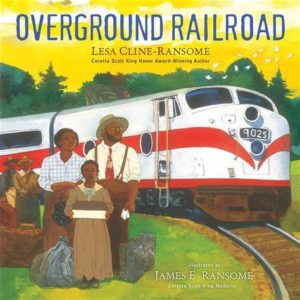32 pages
This month’s PB review is by Ryan G. Van Cleave (Owner/Operator of Only Picture Book) and freelance author/illustrator Kelly Light.
–Ryan’s Review of the Writing–
Whenever I see a husband-wife team do the authoring and illustrating on the same picture book, I’m kind of in awe because it just wouldn’t work for most couples. But for Cline-Ransome and Ransome, it’s a terrific pairing, as we’ve seen with their collaborations on such fine books as The Power of Her Pen: The Story of Groundbreaking Journalist Ethel L. Payne, Game Changers: The Story of Venus and Serena Williams, and Before She Was Harriet.
With this latest collaboration, Overground Railroad, they’re revealing another vital story from African American history. In this story, a young narrator (Ruth Ellen) is taking the Silver Meteor train north with Mama and Daddy to find a new home, a new life, and a new future.
The story is essentially Ruth Ellen recounting her own journey in the Great Migration–the post-Civil War time when millions of African Americans left the South–through prose that’s poem-like at times which allows Cline-Ransome to highlight key words and ideas through lineation choices, as you can see here:
I watch the track
in front of me
and behind me
just as far as the eye can see.
Mama and Daddy say
job
education
freedom
are waiting in New York for us.
Before she left, Ruth Ellen’s teacher gave her a copy of Narrative of the Life of Frederick Douglass, which she reads along the way. As she journeys from a life of oppression to the shining promise of the North, Ruth reads and learns about the social reformer and abolitionist Frederick Douglass. Despite her age, Ruth Ellen finds connections between her life and his all on her own, noting that it’s “the story of a boy / leaving behind what he knew / and heading to what he don’t / just like me.” She also reads aloud from the book, and the changing scenery outside often links up in powerful, symbolic ways.
The various stages of the journey are also effectively punctuated by the conductor calling out the stops (“Next Stop Baltimore, Maryland!” etc.). Though from the start, we’re rooting for Ruth Ellen’s family to finally reach that last stop, which might just be The Promised Land, or so Ruth Ellen hopes.
Upon reaching New York City at last, we see imagery payoff, as Ruth Ellen notices stars the way that Douglass had the North Star guiding him in his own travels. But Ruth Ellen doesn’t just encounter one star. Instead, the last spread shows her “stretch my neck to see / bright lights / tall buildings / shimmering against a sky / bright as a hundred North Stars.” What a lovely, satisfying moment.
In this book, Cline-Ransome doesn’t shy from presenting that challenges Black people faced during this moment in history. It might get emotional for some readers to witness how white people in the white train cars frown upon those who come from the Colored section. But Cline-Ransome gives us–and Ruth Ellen–hope with phrases such as “we keep walking / until we find / smiles / from new neighbors.”
This is a visually lovely book (I’ll let Kelly explain why the illustrations are so apt) whose story has impact and importance. And, if you’re like me (or even Cline-Ransome, who admits in the Author’s Note that she didn’t know about the Overground Railroad until doing her own research), you can learn all about the Overground Railroad itself and get a sense of its place in history.
4.5 out of 5 pencils
–Kelly’s Review of the Illustrations–
In Overground Railroad, James Ransome takes our eyes on a journey with his spellbinding illustrations. Let me explain.
I encourage everyone to use watercolors. The pigments absorb into the paper differently depending on how much water you use or what kind of brush you use: round, flat, wet, dry, or even frizzled. The results change with how much paint has been soaked in the pan with water before you dip into the color. If your paper is dry, the color takes differently than if the paper was wet. Watercolor carries with it an element of unpredictability that can ruin an image, or, in the right hands, what watercolor does can be magic.
Washes, which are larger areas of the paper where a good amount of water was used to move the pigment around, are the wild card when painting in translucent media.
And Ransome’s washes are MAGIC.
Overground Railroad has so many moments of this watercolor magic. I am looking closely at the illustrations and seeing a bit of mixed media. There is collage. There is drawing underneath the paint that is popping through. There is also drawing into and on top of the watercolor. Some of the color is intense, which leads me to believe there is a mix of watercolor and either inks or dyes. Layering these translucent media can give the intensity of color seen in the book’s trees and skies and buildings. The blues and greens ooze out cool tones in contrast to the warmest, loveliest golds, ochres, browns, and my favorite, the pink skies.
I could go on about the media, but I want to talk about the characters and the drawing and the design of this beautifully visualized picture book of a family’s brave journey to a better life. The first design element that made my eyes happy was the white cotton depicted on the endpapers that we are looking through. The un-outlined shapes are bold and pure solid white, and its right in our faces as we peer over the stalks to see images of people leaving. Turn the page and there is a field of pure white shapes leading the eye back to a speeding train in the distance. Before we start to read, we have a feeling that a journey is about to begin.
The very first spread of the book begins, “Some walked. / Some drove. / But we took the train North” and it’s paired with a gorgeous pink sky. It also has the faces of eight expectant Black people waiting for a train to take them from the cotton fields and to a place where they never have to pick it again. The father’s shirt, just slightly yellow in the early dawn light, and the box in Ruth Ellen’s hands simply glow off the page. Here is color composition to allow your eyes to wash over. That sliver of acid yellow on the left, the yellow on the ticket booth, and the glow in the front on the clothing of the family is the sun coming up. Perhaps the dawning of hope?
What moves the eye around the page are the patterns used on the clothing and the bags. Florals, ginghams, stripes, and plaids are used in bold and flat ways. These elements help the washes do that magic but exist in stark contrast of flat color. The detail that Ransome puts into his illustrations is where it needs to be in the faces, which perfectly express mixtures of hope, worry, determination, and wondering what will be next. Every drawn line is as much and as little as it needs to be. Restraint is the word I am searching for. That is when an artist is well seasoned, when an artist knows when to stop and let the image have space to breathe and the viewer’s eye to have spots to rest.
In Art School, we learn to squint at an image to blur out the detail and get the large shapes and values in the composition. While Ransome teaches illustration at my own alma mater, Syracuse University, I was not young enough to have had him as an instructor, though he must be a brilliant teacher of the squinting method. His pink sky in front of the house at dawn, when squinted at, is so vividly real to anyone who ever woke up that early, when the light is so low and all you can perceive is temperature and shape. The abstraction on this spread as well as the spread that is a distant view over the cotton field teases our eyes to see that pattern is everywhere. Turn the page and there are patterns galore!
Patterned trees and birds outside connect back to Ruth Ellen. Check, floral, gingham, homespun–the very fabric of Ruth’s life goes by outside the train as she wonders what her life will look like in the city. Ransome finds ways to weave in the brightest yellow and bold white shapes with the coolness of the blues that take us through a train that has crossed the line that divides South from North. The cool blue inside page turns into the cool river being crossed and into the night sky over Frederick Douglass and into the window surrounding Ruth Ellen’s smiling face as she arrives at New York City. Daddy and Mama share a relaxed moment before twinkling windows and stars and all of the blue paint envelops Ruth Ellen in what lies ahead as she steps out onto the streets of her future.
As an illustrator, one never stops learning. Learning from fellow artists, especially artists who work differently in style and media, is a never-ending joy. This book took me on several journeys of learning, and I am grateful to the Ransomes for the chance.
4.5 out of 5 colored pencils
 Kelly Light lives in Amherst, MA but grew up down the shore in New Jersey surrounded by giant pink dinosaurs, cotton candy colors, and Skee-Ball sounds. She was schooled on Saturday-morning cartoons and Sunday funny pages. She picked up a pencil, started drawing, and never stopped.
Kelly Light lives in Amherst, MA but grew up down the shore in New Jersey surrounded by giant pink dinosaurs, cotton candy colors, and Skee-Ball sounds. She was schooled on Saturday-morning cartoons and Sunday funny pages. She picked up a pencil, started drawing, and never stopped.
Kelly is the author/Illustrator of the Louise series. Louise Loves Art and Louise and Andie, The Art of Friendship are the first two picture books in the series. Louise Loves Bake Sales and Louise and The Class Pet are the first readers in HarperCollins’ I Can Read program.
Kelly has also illustrated Elvis and the Underdogs and Elvis and the Underdogs: Secrets, Secret Service, and Room Service by Jenny Lee, and The Quirks series by Erin Soderberg.
Website: www.kellylight.com


